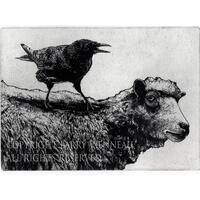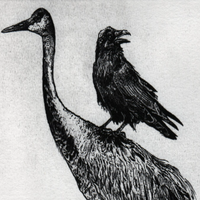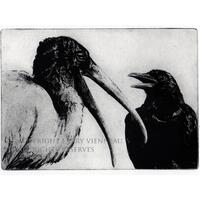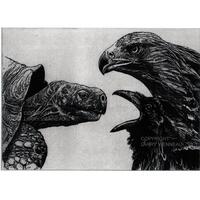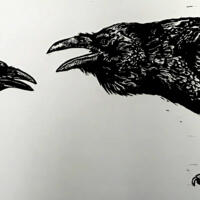About this Product
"DO NOT TRUST FLATTERERS." Etching on Paper, 5 inch by 7 inch r
In many ancient European myth and legends, there was no difference between Ravens and Crows. They were seen as the same bird.
Aesop’s THE FOX AND CROW
A Fox once saw a Crow fly off with a piece of cheese in its beak and settle on a branch of a tree.
"That's for me, as I am a Fox," he said, and he walked up to the foot of the tree.
"Good day, Mistress Crow," he cried. "How well you are looking today: how glossy your feathers; how bright your eye. I feel sure your voice must surpass that of other birds, just as your figure does; let me hear but one song from you that I may greet you as the Queen of Birds."
The Crow lifted up her head and began to caw her best, but the moment she opened her mouth the piece of cheese fell to the ground, only to be snapped up by Master Fox.
"That will do," said he. "That was all I wanted. In exchange for your cheese, I will give you a piece of advice for the future: "Do not trust flatterers."
RavenPrints
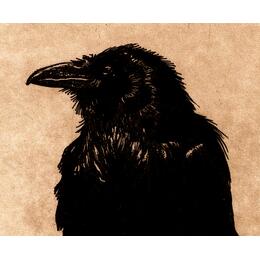
Meet the Maker
RavenPrints
I fell in love with printmaking as soon as I made my first print! It felt like I was opening a wrapped present. It is one of the things that keep me addicted to it. I enjoy painting and drawing but the process of printmaking intrigues me. It is indirect. It is both a craft an art. The unexpected and the accidents of printmaking are the things I look forward to the most. I enjoy getting my hands dirty; printing an etching plate is good and messy. I have done many color prints, but I LOVE black and white. Like the old black and white movies, my prints allow the viewer to use their imagination. Rich bold values can be very powerful and beautiful. Black and white allows the viewer to be more interpretative, to fill in the blacks with whatever color the viewer wants. My prints are about history, I am a history nerd. I love to learn about the past, and about the stories and belief systems of our many ancestors. Each image has an accompanying narrative which is part of the visual image. My artwork also celebrates the intelligent and misunderstood raven and crow.
Please visit my portfolio: https://thevienneau.myportfolio.com/
My Artist Blog: http://larryvienneauprints.blogspot.com/
My Tumbler : https://www.tumblr.com/blog/view/thevienneau
Facebook: https://www.facebook.com/RAVENSTAMP/
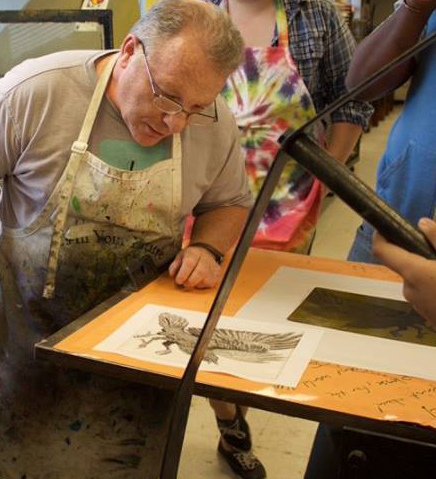
How it’s Made
HOW I CREATE MY PRINTS:
I have had a lot of people ask "What is a handmade print?" I made this video of to show the printing process. http://www.youtube.com/watch?v=DNdYxOSKt1Y&feature=youtu.be
I often find inspiration from a traditional or historic account of the raven. First I decide on my title. Having a title helps me with the image and mood of the piece. Humor is often important but I also select titles that force the viewer to think more about the imagery.
Next, I look through references to find the right pose or gesture for the raven or ravens. Then I spend hours doing preliminary sketches, followed by a series of drawings using pencil, traditional gouache (opaque watercolor), ink, and charcoal. My next step involves using digital technology. I scan the drawings and rework them with Photoshop. This digital tool allows me to adjust the value of the drawing and I can even move and reorganize the image. I use filters if needed. Next, I print the drawing from my computer and continue to draw with the traditional tools. I repeat this process several times so the traditional and new technologies merge seamlessly.
In 2009 I began working with photopolymer etching plates. In the past an etching involved coating the plate with a petroleum bases sealer then emerging the plate into a vat of acid, cleaning with solvents, recoating, and more acid baths. The process was extremely hazardous to the artist as well as the environment. In 2009 I began working with newly perfected and safe photopolymer etching plates. These are UV light sensitive printing plates, which are exposed to sunlight and processed in tap water!! In the past, I spent 20-40 hours creating the printing plate. Now I use that time to do my finished drawing. I use my computer and printer to transfer my drawings onto a transparent plastic sheet. This serves as my negative for the exposure to the sun! I use the photopolymer process to transfer the original drawing to a printing plate from which I can hand-print an edition. Finally, I write a narrative. This usually takes up most of my time!

